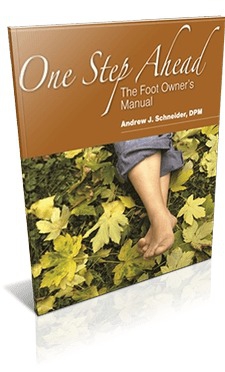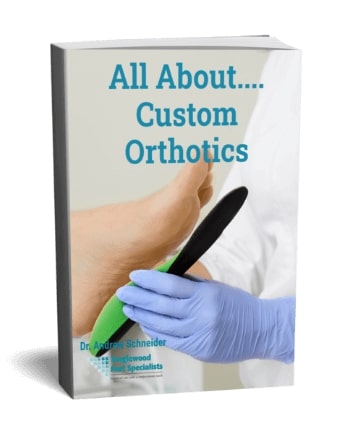Many of my Houston runners wear orthotics in their sneakers. There are many reasons why. Some need these devices to stop their foot pain. Others find it helps them run more efficiently. Whatever the reason, they feel better running with orthotics.
Now, many of those runners have a new question. (Especially when training for a triathlon.) They want to know, "If I wear orthotics when I run, do I need them in my cycling shoes?" Let's find out!
What is a custom orthotic? ![Cycling orthotics in Houston]()
A custom orthotic is a medical device. In my office, I craft orthotics after taking molds of each of your feet. That way, they fit your exact anatomy perfectly, unlike Dr. Scholl's inserts.
Why does that matter? Because they're built just for you, orthotics balance out your feet. And, since your feet serve as the base of support for the entire body, this can help you in many ways.
First, the orthotic can help provide stability and efficiency in your lower extremities. Not only can this help get rid of foot pain, you may notice knee and back pain relief with orthotics, too!
Who Should Wear Custom Orthotics?
Many runners wear orthotics in their running shoes. But they're not the only ones! I've also got patients who wear them in cross-training athletic shoes, work shoes, and dress shoes. Heck, we can even put them in boots! Why try putting orthotics into more than one pair of shoes?
Here's the deal. Your foot mechanics don't change when your shoes do. So, if you wear your orthotics in just one pair of shoes, you'll probably still feel foot pain. But, if you transfer orthotics between shoes? Or get a second pair to cover you? Well, you'll enjoy consistency of mechanics, improving your foot and ankle function in every situation. And, with that said, we can finally start talking about cycling.
Why is Cycling Hard on Your Feet?
Many people incorrectly think of bicycling as a non-weight-bearing activity. And I see their point. After all, when you ride, your feet do not touch the ground. But your feet still do a whole lot of work when you ride.
Remember: when you cycle, your feet push off on those pedals. So, whether that's outdoors or in the spin studio, it means putting pressure on your feet. In fact, cycling is a weight-bearing activity.
Even worse? It provides repetitive stress on your foot and ankle. And that can take on a few different forms. If you cycle with clipless pedals, you place continuous pressure on the forefoot. This makes your foot and ankle work differently than during your natural walking gait. Which can lead to pain and other problems.
But that's not all. Even if you use a clip-in pedal, you put tons of pressure on the bottom of your foot. Plus, when you bike standing up, your foot tends to flatten, causing your arch to collapse. In turn, you may experience heel and arch pain. Or, over time, you may even develop plantar fasciitis.
Don't Hard Cycling Shoes Protect my Feet? ![cyclist on bike]()
This is a valid question. Why wear custom orthotic when cycling shoes are designed for this sport? Don't they give me all the protection I need?
I hear you on this, I really do. But I have to tell you a hard truth. Cycling shoes can actually cause some of the foot pain you may be experiencing.
First, they're hard. That's not in itself a problem. But if your shoe fit isn't great, your feet can slide around in those cycling shoes. And if your nail keeps banging against the hard edge of that shoe? You could be staring down the barrel of ingrown toenails or black toenails. Just like my Houston runners.
So, you don't want loose cycling shoes. But guess what? If your riding shoes are too tight, that can also cause problems. Overly snug cycling shoes compress the arch of your metatarsals, which crosses the ball of your foot. When that happens, your foot may go numb. Or, you may notice stabbing foot pain while you cycle.
Now, some of the better brands of cycling shoes come with wedges you can stick inside to improve shoe fit. And these can help you a little with the problems I just talked about. But they can't correct your foot's biomechanics. So you may still experience foot pain while cycling. Even if you have a cycling shoe that technically fits you just right. Which, of course, brings us back to the question of orthotics for cycling shoes!
Should I wear an orthotic in my cycling shoes? Absolutely!
By now, I've clearly proved that cycling puts pressure on your feet. And I'm pretty sure you also understand why cycling shoes can hurt your feet as well. But are you ready to guess the solution to these problems?
Because you're clearly wise--you've stayed with me this long, after all--it must be obvious. You should try wearing an orthotic in your cycling shoes. Not always, but often.
There are several circumstances when I suggest wearing orthoses in cycling shoes. The first? If you have mechanical instability involving the forefoot. But also, if you have an angular instability of the leg. In both these cases, an orthotic in the cycling shoes would be helpful.
Now, some people are comfortable wearing the same orthoses in their running shoes and in their cycling shoes. But that's not always the case. Others, especially elite cyclists and ironman triathletes, need a bit more support. In these cases, we can create specialized orthotics designed specifically for your cycling shoes.
Regardless of the kind of orthotic you're looking for, you need to visit your foot doctor in Houston for a fitting. Because these are custom medical devices, you simply can't get them over the counter. Ready to fight foot pain in the saddle? Schedule an orthotics consultation in my office. Together, we'll decide which type of orthotic is the right choice for you.

_medium.png)


















